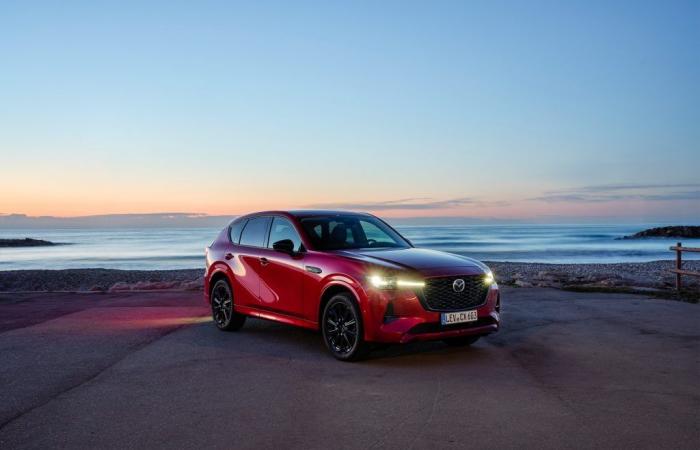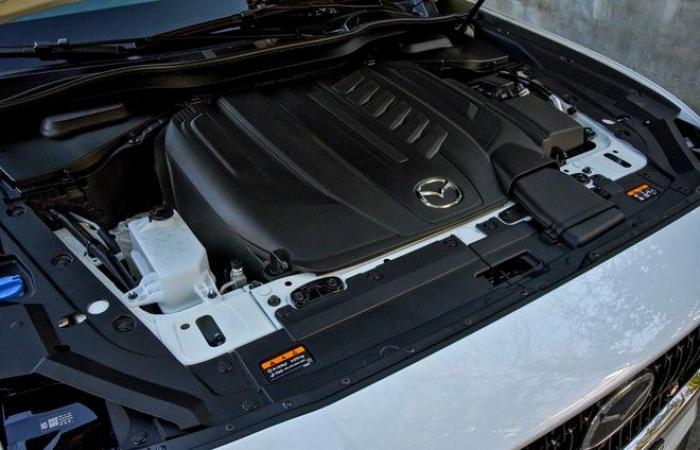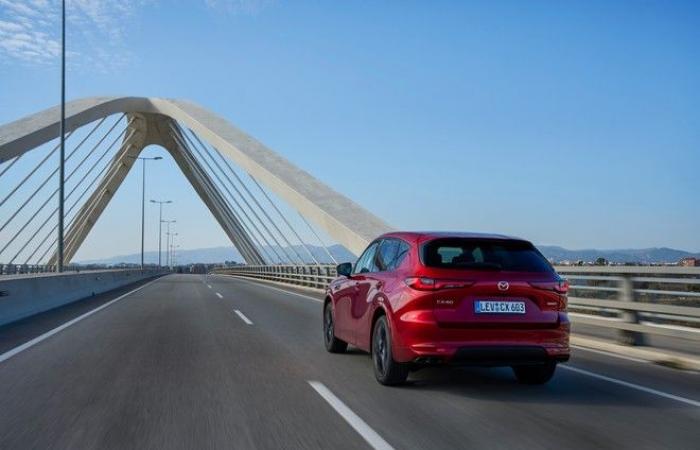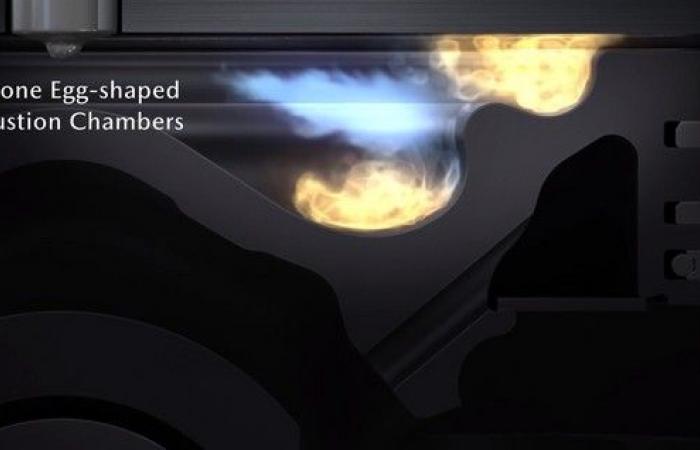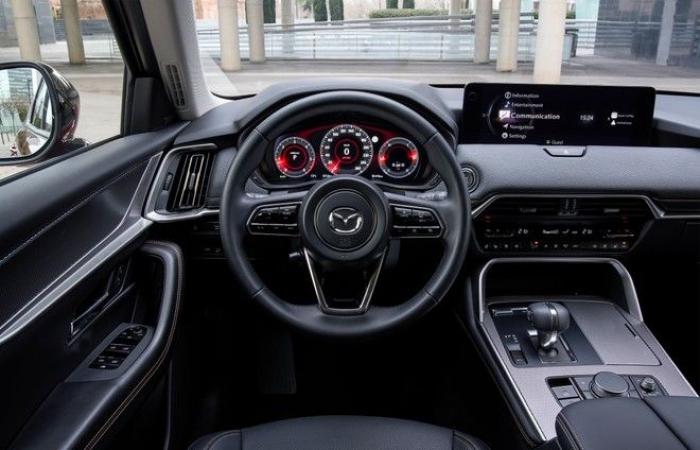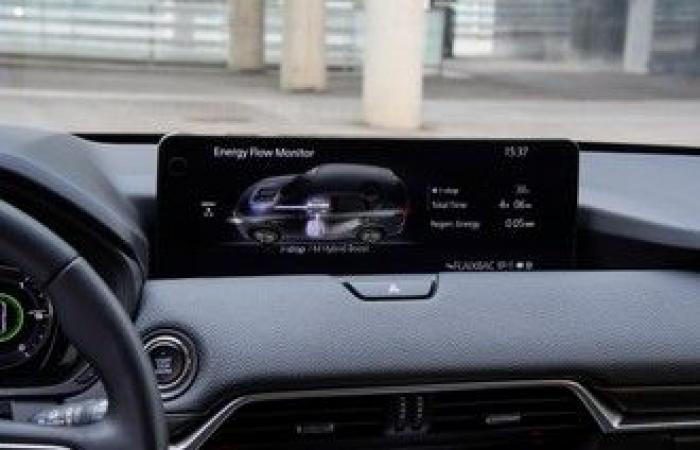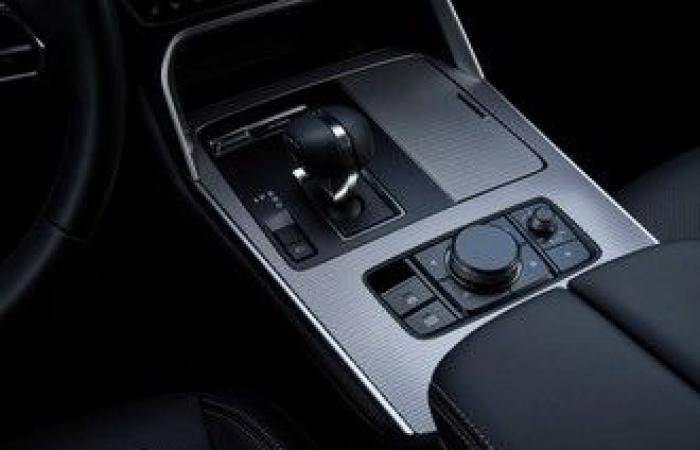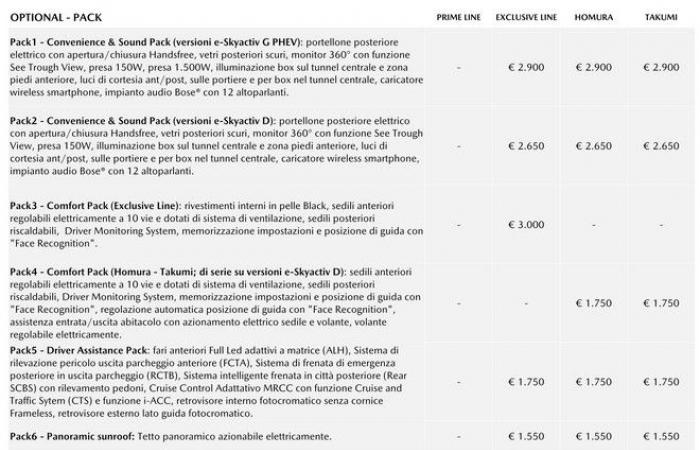Mazda CX-60 is a spacious D-segment SUV with a huge diesel engine. Indeed two versions of the same diesel engine. And it comes out in 2023. Raise your hand if you don’t believe the sentence you just read…
Yes, because despite having made its debut in the plug-in version, and for the complete test I refer you to that article and the related video given that the car does not change in substance, the Mazda CX-60 is such a particular car that it has decided to allow you to choose between two 6-cylinder diesels (in line) and, in the future, will also offer a 6-cylinder petrol, the Skyactiv-X in the 3.0-litre version.
Car
04 May
Diesel is going to disappear, it is true, but IHS estimates that in 2030 there will still be an annual demand of 1 million diesel for motor vehicles and today, data updated to the whole of 2022, the demand for diesel in the D-SUV segment is still very high, equal to 73% in Italy.
HOW MUCH THE 3.3 LITERS DIESEL CONSUMES
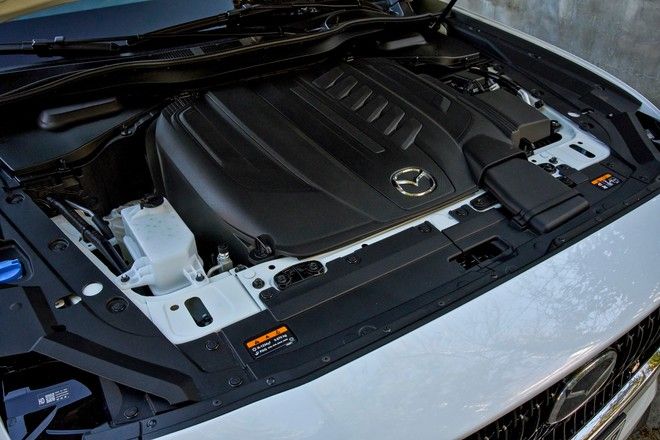
Data is needed to better understand the numbers that I will mention below, and a small preamble is also needed. The test was carried out with the CX-60 diesel with 200 HP and 450 Nm of couple, a 48V Micro Hybrid Diesel aided by a small electric motor. The set-up used was, as usual, one of those complete with everything, including the panoramic glass roof, and the conditions were for two passengers on board.
Passengers aside, the most interesting thing to consider is that in this trim level the CX-60 weighs 1,832 kilograms empty and without the driver (the basic range version weighs 16 less).
Keep these numbers in mind because we need further introduction: Mazda’s trial was staged as a consumer race, pushing us to try and win. As often happens in these situations, two factions are created: the first is that of those who try to compete, and the second is that of those who completely ignore the competition (also because they competed for glory) and take advantage of it to have fun, especially considering that the route was very interesting: starting from Sitges (Calafell to be precise) we tackled a part of the motorway, then the extra urban fast-flowing, the uphill hairpin bends towards the mountains exceeding a thousand meters in altitude, and finally the return to the sea.
After the event it was interesting to analyze the consumption data: who competed with more conviction has made consumption around 4 liters per 100 kilometres While those who decided to just drive kept between 5.5 and 5.8 liters per 100 kilometers. These are very interesting results because they show that Mazda’s diesel is really capable of doing what it promises in a mixed route like the one highlighted.

Those of Mazda are gods madmen, we know by now. First they set out to create the Skyactiv-X, the petrol that believes itself to be a diesel. Then they decided that on the one hand they will offer choices for those who are already ready for electrification, from the battery-powered Mazda MX-30 to the CX-60 Plug-In, passing through the MX-30 ReV with the Wankel engine. And today they make their debut with a 3.3-litre 6-cylinder diesel and 200/249 HP of power.
The range has never been more varied because it satisfies those who want the small aspirated on the light compact, those who want the six-cylinder petrol, those who want the gigantic diesel with lots of torque, those who want the city electric and they also have the best hybrid (borrowed from Toyota) on the Mazda2 Hybrid.
They make them in all colors so that you can choose according to your preferences, a different strategy from other manufacturers who are instead setting a more defined path and, for example, diesels are making them disappear.

Car
Nov 14th

Mazda
19 July
Considering the results of this first road test also aimed at evaluating consumption, it certainly cannot be said that they were not right in obstinately researching the thermal efficiency of traditional engines. Yes, it is true that there is also an electric motor here, but it is small (while contributing 153Nm of torque).
However, the great work is done by the design of this diesel which, above all, is contrary to any downsizing logichas a displacement of 3.3 liters and therefore a more than generous back: imagine him as a big man one and a half meters wide carrying a kindergarten backpack on his back: no effort!
In addition to the displacement there is more, in particular cylinders and injectors. The latter work at 2,500 bar of pressure and have achieved such precision that in the combustion chamber, a chamber made like this
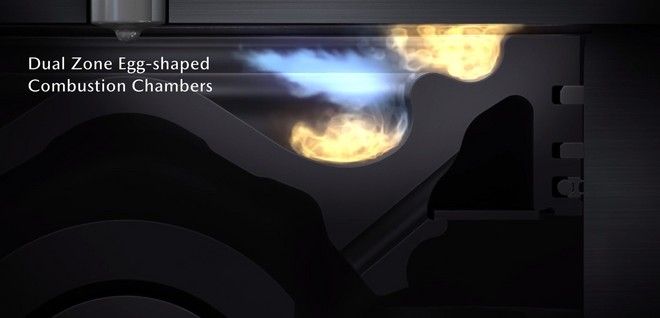
the injections follow each other in imperceptible instants, but with a very precise frequency and spatiality, aimed at creating a homogeneous mixture so that when detonation occurs, two results are obtained: sufficient power and greater efficiency, not only in terms of consumption, but also in terms of combustion cleaning. The cleaner the combustion, the lower the particulate emissions.
The result is lean combustion at multiple revs which broadens the range of use and explains very well why this SUV consumes less fuel than some wagons. A generic motor can work very efficiently, but usually this area of efficiency is limited and it is difficult to apply it to real life. Translated? Theoretically it consumes little if you make it work as it says, but it’s your foot (and the traffic, and reality) that rules and therefore he will almost never work where he wants.
So Mazda chose not to force the driver to do what the engine says. Rather it made the engine much more supple in its efficiency zoneso in “casual” driving, the one that is not very careful which characterizes most drivers, it is easier for “the foot” to fall in that area of the graph.
Accustomed to different electric cars, it’s difficult for me to make a comparison in terms of noise, especially because it’s been a really long time since I’ve had a diesel in my hands. In general, however, the passenger compartment is well insulated and the six-cylinder enters with a good pleasure but without exaggerating, croaking a bit in some situations.
The new gearbox works well with this unit: in relaxed driving the changes are imperceptible and it remains a little abrupt only in first/second gear from stressed foot in city traffic. The default mode is Normal, the equivalent of an “eco”, the one to be used every day. In Sport we find more responsiveness to the pedal and a different shifting logic of the eight-speed, which is never lightning fast but is fully committed to the limits of its technology: it improves a lot compared to the old six-speed and is all in all commensurate with the type of cars we are talking about.
Excellent integration between engine, gearbox and electric motor. The electric is interspersed in the kinematic chain by two clutches, and this allows you to disconnect the thermal (turning it off) and sail pushed by the electrons. There battery (0.33 kWh) does not allow you to do kilometers, but they are i many and repeated moments of sailing which allow you to save a few drops of diesel while maintaining cruising speed for those stretches. And if the route is mixed, the recovery allows us to do many of these sailings given that in 200 kilometers we have generated 1.3 kWh of electricity spent in all the sailing moments.
TECHNICAL SHEET AND DIMENSIONS (e-SKYACTIV D 3.3 200-249 HP)
TECHNIQUE
- ENGINE: Euro 6d, 3.3 liter diesel, 6-cylinder in-line micro hybrid 48V
- POWER: 200 HP between 3,600 and 4,200 rpm – 249 HP @ 3,750 rpm
- TORQUE: 450Nm – 550Nm
- TRACTION: rear – integral
- GEARBOX: 8-speed automatic
- SUSPENSION: Double wishbone (ANT), multi-link (POST)
DIMENSIONS
- LENGTH 4.740 mm
- WIDTH: 1,890 mm (without mirrors)
- HEIGHT: 1,682mm
- WHEELBASE 2,870 mm
- BOOT: 570-1,726 litres
- WHEELS: 18″-20″, 235/60 R18 or 235/50 R20 tires
- WEIGHT: 1.816-1.884 Kg (empty, without driver)
- DISCS: 4 x 328 mm ventilated discs
PERFORMANCE
- MAXIMUM SPEED: 212km/h – 219km/h
- ACCELERATION 0-100 km/h: 8.4 seconds – 7.4 seconds
- CAPACITTO DI TOWING: 2,500 kg with brake, 8% gradient
- FUEL CONSUMPTION: 5 – 5.3 l/100 km (WLTP combined)
- CO2 EMISSIONS: 128-139 grams per km (WLTP combined, battery charged)
PRICE: from €49,900
PRICES AND EQUIPMENT
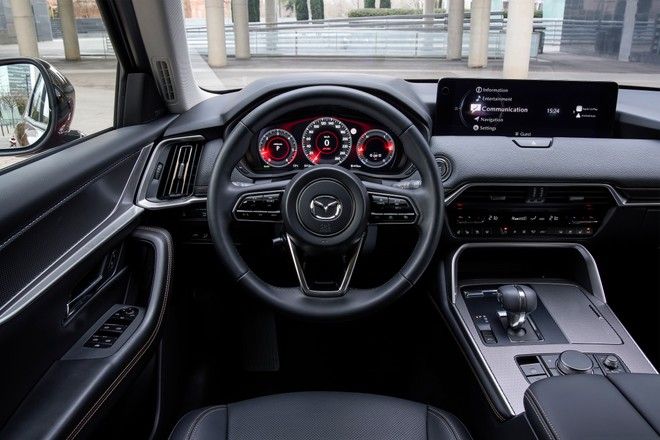
Mazda CX-60 diesel costs €49,900 in the 200 HP diesel version. The diesel with 249 HP and 550 Nm of torque will arrive later, the latter in the €55,550 price list.
They may seem like huge figures, but in this range it is several thousand euros less than the German and Italian competitors, all with more power under the hood and a better technical data sheet in general. The opponents of CX-60 have names and surnames, the Japanese have no qualms about mentioning them in the press conference.
The 200 HP CX-60 challenges the stelvio, which at €59,800 stops at 160 HP (but has sportier driving dynamics), the Volvo XC60, with equal power but with a price of €63,109, the Audi Q5 (163 HP and almost €65,000) and the BMW X3 which is the most expensive in the list, with 150 HP and €66,110. With such low fuel consumption, despite being an SUV, the CX-60 could also undermine some station wagon customers: A4 Avant, C-Class and 3 Series Touring just to mention the German triad…


Prime Lines it is the starting set-up and it is already very complete: 18″ alloy wheels, LED headlamps and taillights, fully electric exterior mirrors (heated, foldable and adjustable), fabric interior, front seats with 6-way manual adjustment, leather multifunction steering wheel, rear seats 40/20 /40, LED interior lighting, 12.3″ digital instrumentation, dual-zone automatic climate, cruise control, rear parking sensors, light and rain sensors, burglar alarm, 12.3″ infotainment with navigator, Android Auto Wireless, Apple CarPlay Wireless, remote connection via App, 8-speaker system, two front USB-C and all the safety technologies (anti-collision with automatic braking, blind spot and reverse traffic monitoring, driver fatigue detection, lane keeping, signal recognition, emergency braking at junctions and on the motorway,

Exclusive Line is the one I recommend: it costs €51,900 and has 20″ alloy wheels, LED daytime running lights, head-up display, front and rear parking sensors, rear view camera, keyless, winter pack (heated seats, steering wheel and windscreen), 8-way electric driver’s seat, lighting internal ambient light, rear vents and two rear USB-Cs (in addition to the front ones).
The Convenience & Sound package is free until March 31st and the choice of a simple price list with the accessories collected in a series of easily readable packages without chaining constraints is commendable, i.e. the choice of one does not require the purchase of one or more options as happens elsewhere.
VIDEO

